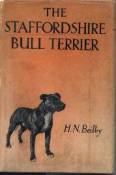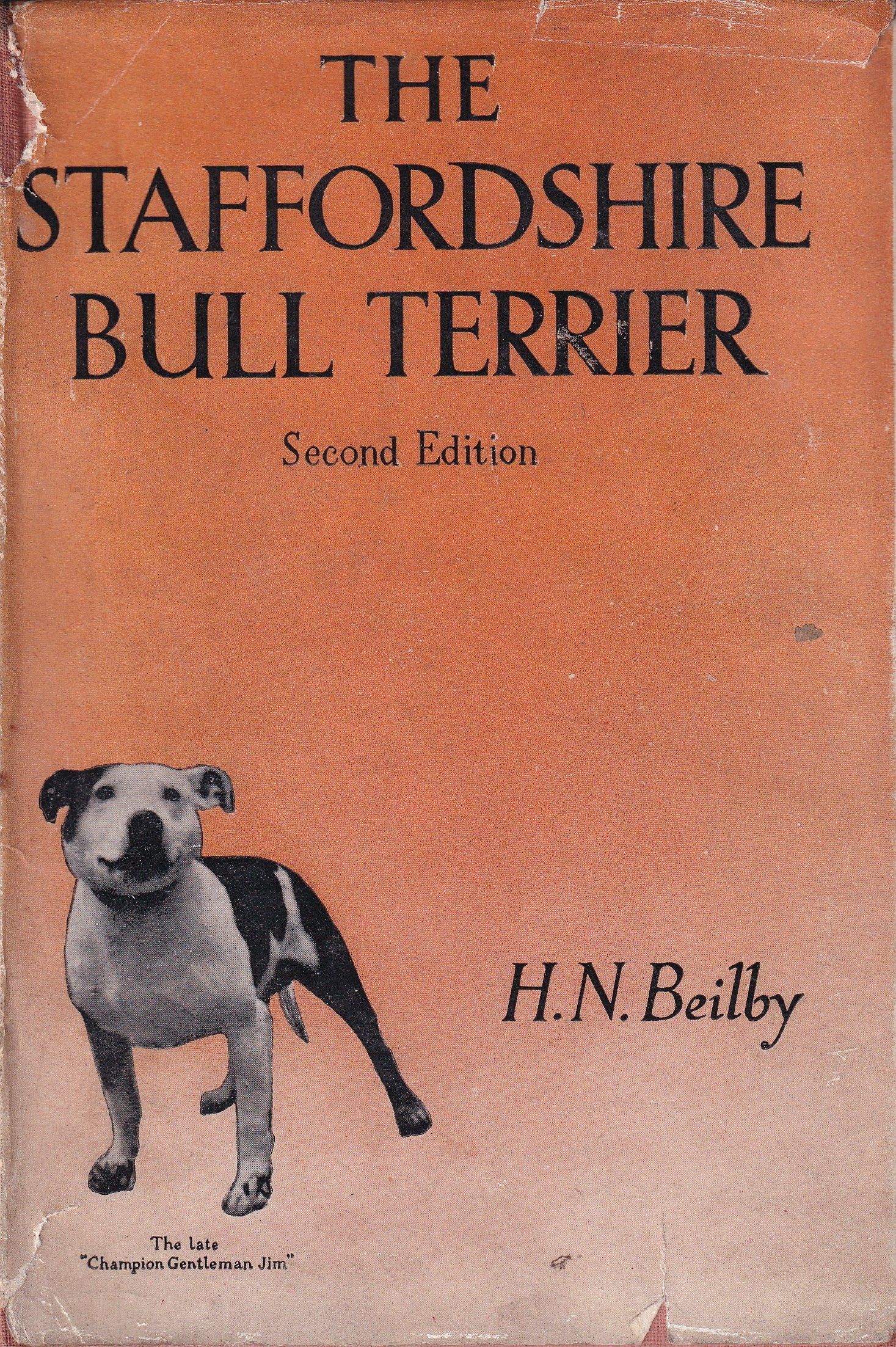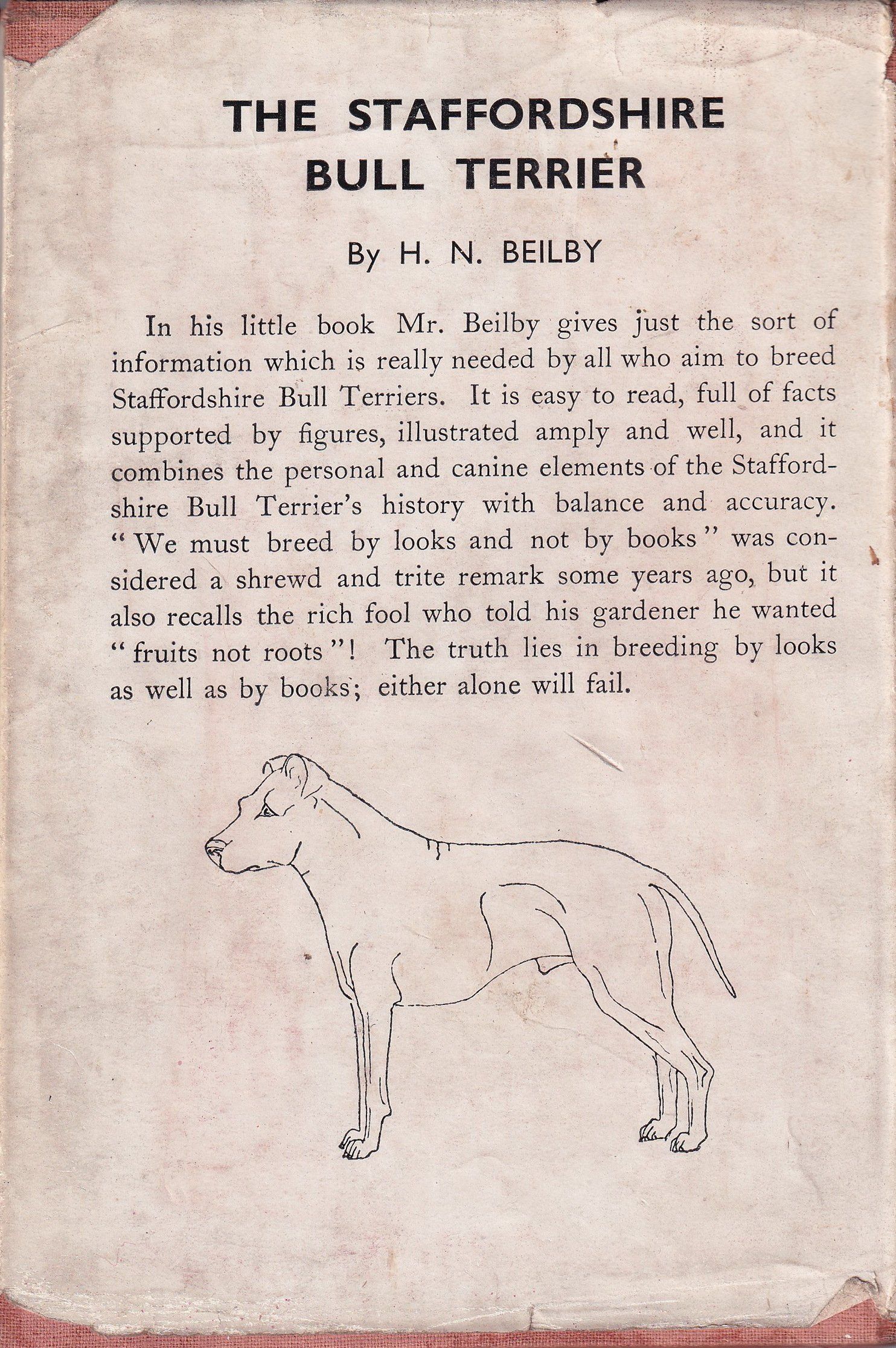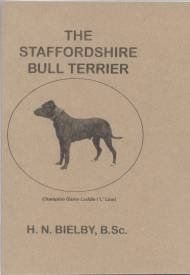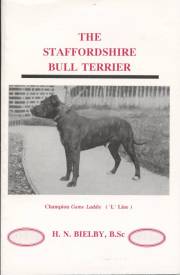First Published: 1943
First Published: 1943
Reprinted 1945
Second Edition 1948
98 pages
Product Dimensions: 13cm x 19cm approx
Book Weight: 170g approx.
Printed in Great Britain by Blackie & Son, Ltd., Glasgow
Facsimile Copies:-
Third Edition 1993 * Beech Publishing House
Fourth Edition 1997 * Beech Publishing House
Fifth Edition 2011 * Beech Publishing House
Book Description:
Why am I setting out to write this book? There are a number of reasons; none perhaps by itself provides justification for the attempt, but possibly when taken together they constitute some sort of excuse - I hope so!
The most important to me is that I have a great admiration for this grand old variety of Terrier and, since the early nineteen-thirties, have had the good fortune to be closely in touch with that sporting and good-hearted body of enthusiastic men and women who have been associated with the breed for many years-in some cases a lifetime-and but for whose efforts and interest the Staffordshire Bull Terrier might, quite possibly, have ceased to exist.
CONTENTS
Foreword
Introduction
Origin
Modern History
Modern Records
Main "Lines"
"Families" of Bitches
Our Standard - The Ideal Staffordshire
Pedigree
Breeding Problems
Colour
Further Notes on Colour Inheritance
Character and Temperament
Exhibiting
The Future
FOREWORD
Mr. Beilby has invited me to write a "fore-word"; one wishes he would accept four words and one dash: "This is——good stuff!"
There is no doubt that he has produced a really monu-mental work, which will be a canine classic for several generations. Every Terrier man should read it. " We must breed by looks and not by books " was considered a shrewd and trite remark some years ago, but it also recalls the rich fool who told his gardener he wanted " fruits not roots!" The truth of course lies in breeding by looks as well as by books; either alone will fail.
Mr. Beilby's book is a model of the sort really needed; it is easy to read, full of facts supported by figures, illustrated amply and well, and it combines the personal and canine elements of the Staffordshire Bull Terrier's his-tory with balance and accuracy.
To one who was lucky enough to have charge of a Bull Terrier Champion over fifty-five years ago and so learned to love that breed both early and dearly, the first mention of a Staffordshire Terrier twenty years later seemed merely stupidity or impudence, as though someone were to speak of his kennel of "Berkshire" Terriers! The consequent argument was concluded definitely against the actual existence of a Staffordshire by the emphatic steam-roller verdict " The Kennel Club knows nothing of them ".
The villain of that thirty-five years old tragedy of ignorance is grateful to his friend, Mr. Beilby, for allowing him to pay to the Staffordshire, as one of the most progressive of breeds, a tribute in reparation of his former lack of recognition.
He is amused to see his own thunder stolen on page 65 with a Staffordshire taking the part of the original hero, but he is even more gratified to find the (“Lines " and " Families " system, known as the Bruce-Lowe system, which he transferred from thoroughbreds to terriers some twenty years ago, adopted and adapted to the needs of another short-coated, straight-legged, and essentially British Terrier.
One word of warning; let no one think that the study of the real or full value of a pedigree is easy and simple; it requires a certain amount of concentration, for instance, to distinguish between a Staffordshire who is A a, B b, C c, E e, and one who is A A, B b, C c, e e, and many there be who will enjoy the book without ever becoming familiar with these helpful but apparently rather alge-braical formulae. "Many men, many women, many tastes." But we, who know, recognize that there is much more to be learned of a well-bred Terrier's history than that his sire was a Champion and that his dam was both got and whelped by two Champions, however good.
Of the fourteen chapters, a table of which appears on an adjoining page, the last is entitled " The Future ". Those of us who haunt Dog Shows, cannot have failed to notice that a different temperament exists among the adherents of different breeds; at some benches the ex-hibitors are exclusive and almost forbidding to the ordinary observer, whilst at others each passer-by is given the impression that he is a welcome spectator. May one, who has been attending these Shows for nearly sixty years, bear witness to the fact that the popularity of a breed much depends upon this point, and he has already observed upon several occasions that Staffordshire ex-hibitors are also dog-lovers, with the courteous concern for the care and comfort of other exhibitors which makes the " Dog game " such a success? This catholic outlook is easy and natural to some people but to others it needs a " nelovan " effort! It is, however, well worth it.
" Tough Guy " was once heard to say at the ring-side, "Decent fellow that Judge to-day, his manners were almost canine!"
ROSSLYN BRUCE.
HERSTMONCEUX RECTORY, SUSSEX
21st October, 1943
INTRODUCTION
Why am I setting out to write this book? There are a number of reasons; none perhaps by itself provides justification for the attempt, but possibly when taken together they constitute some sort of excuse - I hope so!
The most important to me is that I have a great admiration for this grand old variety of Terrier and, since the early nineteen-thirties, have had the good fortune to be closely in touch with that sporting and good-hearted body of enthusiastic men and women who have been associated with the breed for many years-in some cases a lifetime-and but for whose efforts and interest the Staffordshire Bull Terrier might, quite possibly, have ceased to exist.
Probably the largest group of these enthusiasts is to be found in the country lying near and around the north of Birmingham, but there is an ever-increasing body in the London area and many smaller groups throughout the North Midlands and even as far north as Newcastle-onTyne and Scotland.
I shall be referring later on to some of these outstanding admirers of the Staffordshire, in considering the influence they have had on building up the strong position which our breed now enjoys.
Another reason is that I feel some record ought to be kept of the emergence of the breed from the comparative obscurity under which it has lain for the last hundred years or so into a position which bids fair to rank high in dog-dom.
Now is the time, when we are laying down the foundation for the future (and we shall never be in a better position than we are at present) to record as far as possible the main " lines " and " families " from which our most successful dogs and bitches are derived. I have dealt with this aspect in the chapter on Modem History.
The Staffordshire Bull Terrier has had a long and interesting history. A good deal has been written on the subject but, so far as I am aware, no attempt has been made to present a collected and reasonably comprehensive story of the breed. This is probably accounted for by the fact that, although the Staffordshire has been known more or less in its present form for about I50 years, it suffered a decline early last century, and it is only within the past ten years or so that, thanks to the perseverance and enterprise of its admirers, it has staged a sensational " come-back".
Major Count Hollender, in his book on the Bull Terrier, devotes a couple of most interesting chapters to the breed which are well worth reading, as he presents the picture from the point of view of one who has a very wide experience of all types of Bull Terrier, whites and coloureds, as well as Staffordshires.
The first Secretary and virtual founder of the Staffordshire Bull Terrier Club, Mr. Joe Dunn, has published several editions of a monograph on the breed which has been warmly welcomed and is, I believe, now out of print.
Mr. Jack Barnard, the first President of the Staffordshire Bull Terrier Club, has issued an attractive pamphlet in which he presents an interesting resume on the Staffordshire.
So far as I am aware, these are the only publications which deal with our breed from a more or less specialized point of view.
There is, of course, that fascinating story of a Staffordshire Bull Terrier, Jock of the Bushveld, written by Sir Percy Fitzpatrick, published by Longmans, Green & Co., which all lovers of the Staffordshire should read.
The third reason, and perhaps the most important, is that there are many signs and portents that when normal times return the Staffordshire will, by his intelligence and general usefulness, make a very strong appeal to householders as a companion and houseguard. Even at the present time, when feeding presents rather a problem, the demand for stock is keen and the limited stock available is barely adequate to meet it. If this continues and develops it is to my mind of the greatest importance that owners, both actual and potential, should have at least some idea of what a Staffordshire should look like, and the main faults and weaknesses to guard against when purchasing, not only for their own sake but for the good of this grand old breed, which is far too fine to spoil.
If the Staffordshire should suffer from a boom, even a moderate one, it will inevitably mean that prices will remain high and the tendency will be for mushroom breeders to turn out large numbers of dogs which will be sold as Staffordshires and bought by a gullible public, even although they (the dogs of course) possess but few of the physical and mental attributes which are characteristic of the variety. If the following pages can help to prevent such a situation from arising, so much the better!
My last reason for embarking on this small book-not a very good one I'm afraid-is that during the last few years a number of breeders, who ought to know better, have been rash enough to suggest that I might do so.
The very limited number of publications for which I have hitherto been responsible have been confined to matters of a somewhat scientific nature and are, I feel, no adequate preparation for this job. However, I'm willing to try anything once, so here goes!
LIST OF PLATES
A STAFFORDSHIRE OF 75 YEARS AGO——WESTALL STRAIN - - - - - Frontispiece
CHAMPION LADY EVE
A GOOD JOKE' FEARLESS
JOE is AMUSED
VINDICTIVE MONTY
JIM THE DANDY
TACKLE; THE GREAT BOMBER
GAME LAD
CHAMPION GAME LADDIE
BRIGANDS BASH'EM
CHAMPION MADCAP MISCHIEF
OUR BEN
CHAMPION GENTLEMAN JIM
TOUGH GUY
EAGER LAD
QUEENIE
BRAVE NELL
RED RUIN AND CHAMPION MIDNIGHT GIFT
TEXT ILLUSTRATIONS
OLD-TIME BULLDOG
OLD ENGLISH TERRIER
STAFFORDSHIRE BULL TERRIER
TYPICAL STAFFORDSHIRE
HEAD PROFILES
RIBS AND SHOULDERS
EARS
FEET
FRONTS
BACK LEGS
REAR VIEWS
NOTE TO SECOND EDITION
The manuscript for the first edition of this book was completed at the end of 1943. It is now the beginning of 1947 and much has happened in the Staffordshire world since the former date. It seems appropriate therefore, at this stage, to amplify and extend the various records that were commenced in the earlier publication.
Opportunity has also been taken to introduce some notes on the question of measurement, which has been raised from time to time in the canine press and elsewhere. It is realized that measurements are only of use as a guide to the newcomer, and are of little or no value to the experienced breeder; the former must remember too, that correct measurements do not necessarily ensure a good Staffordshire, although they certainly help to that end.
----
OBITUARY
H. N. Beilby, B.Sc.
On Thursday, April 22nd, 1954, Mr. H. N. Beilby died. And so passed on one of the personalities of the Staffordshire Bull Terrier Fancy.
Mr. Beilby moved to Birmingham in 1930 and thereafter, being for many years prior to this very interested in various other breeds, made his first contact with the Staffordshire Bull Terrier. No matter what his interest in other breeds prior to this, it can be safely claimed that the Stafford seized his interest to the virtual exclusion of all others.
It was not long before he commenced collating all available information on the Breed and was present when, in 1934, a handful of enthusiasts foregathered in Cradley Heath to discuss the initial steps to secure Kennel Club recognition for the Breed. As a member of the Kennel Club himself for many years he was able to give valuable assistance in securing recognition and in drafting the original Standard of the Breed.
Mr. Beilby was a founder member of The Staffordshire Bull Terrier Club and in 1935 was a Vice-President in such notable company as Messrs. G. A. Dudley, H. Melling, J. Mallen and Phil Dee, under the Presidency of Mr. J. Barnard. He judged the first Show ever held by the Club and his services as a Judge were much sought after from then until incapacity prevented him from carrying out these duties.
In 1936 he became President of the S.B.T.C. and towards the end of that year helped Southern Fanciers in the formation of the Southern Counties Staffordshire Bull Terrier Society, which body made him a Life-Vice President in 1950.
He bred and showed several good Staffordshires, notable for their clean and active conformation and was planning an extensive and ambitions breeding programme, having converted the spacious stabling at his house for this purpose, when doctors completely vetoed all such activities.
This was a sore blow to him, but his knowledge and experience was not to be denied the Breed, as he became the mentor and instructor of many breeders. His services in this connection were constantly in demand and many breeders owe their success to him.
Mr. Beilby was the first to appreciate that the progress of the Staffordshire Bull Terrier was greatly handicapped by the absence of anything but the most sketchy breeding records. Owing to the fact that until recognition, Staffords were not to be seen at Shows, the study of pedigrees meant little to the wouldbe breeder who was lucky if he had seen even the sire and dam of his bitch. Mr. Beilby undertook the selfappointed task of reducing this insuperable difficulty to successful breeding as quickly as possible.
He introduced a system of 'Lines' and ' Families ' for Staffordshire Bull Terriers which is now wellknown and fully appreciated by all our readers.
Having collected much information on the tap-roots of the Breed and tabulated them, he made the fruits of his labours available to the Fancy in his first book, published in 1943, reprinted in 1945, and followed by a second edition in 1948.
Thereafter, he regularly contributed to The Stafford and was well to the fore in any discussion on any important feature of the Breed.
In 1948, when the Kennel Club decided to adopt official Standards for all Breeds - prior to that the Standards were the property of the various breeds - a meeting to which representatives from all the Breed Clubs were invited, was held at Wolverhampton. Mr. Beilby presided at this meeting and to his ability as a Chairman was added the knowledge and experience gained from that historic meeting which drew up the Breed's first Standard. Everybody that attended the Wolverhampton meeting fully appreciated the manner in which he conducted the proceedings which went smoothly and without a hitch, to the profound satisfaction of all concerned.
It was indeed fortunate for our Breed that, from the time of its inception, it could call on the services of one whose scientific training and wide canine experience made him pre-eminently suitable for the role he was to play. Through his efforts the Breed has made fifty years' progress in less than half that time. As well as possessing the enthusiasm and application to devise methods of tabulating the various strains in the Breed, he also demonstrated his ability to clearly visualise the correct conformation of our Dog and to expertly anticipate trends in its development. Nothing could better illustrate this than an article by him in 1935 which, if anything, is truer to-day even than when it was written. (This article is reprinted in the current issue - Ed.).
Mr. Beilby has blazed the trail for Staffords, we owe it to him not to let it become overgrown and lost.
A.W.A.C.
The Stafford - Summer 1954

